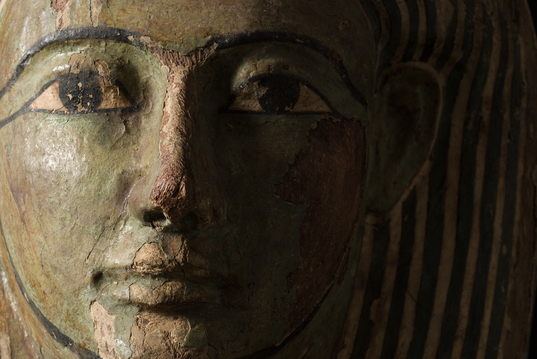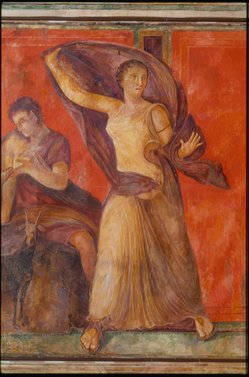Kelsey Museum's expansion moves more treasures out of storage

The coffin of Egyptian priest Djehutymose (685-525 BCE) is one highlight of the University of Michigan's Kelsey Museum of Archaeology's collection. The museum celebrates the opening of the William E. Upjohn Wing on Sunday.
Image courtesy Kelsey Museum
The new expansion was made possible by a $8.5 million gift from the late Edwin and Mary Meader and an additional $200,000 from the National Endowment for Humanities. Mary Meader, a renowned aerial photographer, was the granddaughter of William E. Upjohn, a pharmacist who developed pills that dissolve easily in the human body. As the story goes, when Edwin Meader was a student at U-M, he “saw rare artifacts, pottery and sculpture, excavated by U-M scholars in the Mediterranean and Near East, being delivered to what was then called the Museum of Classical Archaeology (later the Kelsey Museum of Archaeology) and said to himself, ‘These things deserve a better place,’” according the museum.
The Kelsey Museum has more than 100,000 artifacts from ancient and medieval civilizations, including Egyptian, Persian, Etruscan, Greek, Roman and Islamic objects. A large portion of the Kelsey’s collection were found during excavations executed by U-M in Egypt, Turkey and the Middle East in the 1920s through the 1940s. The Kelsey Museum also holds numerous additional artifacts, which they purchased or acquired through gifts.
Before the expansion, the Kelsey Museum could only accommodate less than 1 percent of its collection in public displays — fewer than 300 artifacts. Now, well over 1,000 objects are on display in the museum, and they plan to display an additional 500 or so in open storage drawers throughout the Upjohn Wing. Individual display cases highlight distinct cultures and excavation sites; however, they also show “the interconnections among cultures and peoples,” according to the Kelsey Museum.
Associate Director Lauren Talalay explains that the displays do not “isolate cultures, but show how they are connected.” The artifacts also educate museum visitors about the daily lives of an ancient people — the objects they utilized in daily life, rituals, burial practices — that offer insight into their world-view and traditions.

Maria Barosso’s watercolor replica of a Pompeiian wall fresco (seen in detail here) is one highlight of the Kelsey Museum of Archaeology's collection. The museum celebrates the opening of the William E. Upjohn Wing on Sunday.
Image courtesy Kelsey Museum
A dedication and ribbon cutting ceremony for the Kelsey Museum’s new William E. Upjohn Wing will be held on Nov. 1 at 2 p.m. at the Maynard Street Entrance, and a reception will follow, from 2:30-5 p.m.
The Kelsey Museum of Archaeology is located at 434 South State Street, with access to the William E. Upjohn Wing off Maynard Street. Visit the Kelsey Museum web site for more information on the museum and their collection.
Jennifer Eberbach is a free-lance writer who covers art for AnnArbor.com.


Comments
redhead74
Mon, Nov 2, 2009 : 12:25 p.m.
What a great addition to a town filled with special places. I have not been to the "Mummy Museum" for many years-since I was in high school. I can not wait to see the new exhibits. Thank you to the Meader family for keeping art and history alive!
Dr. I. Emsayin
Sun, Nov 1, 2009 : 8:41 a.m.
I feel for "overtaxed". Universities such as UM spend money on so many things to make it a world class institution. People living in Ann Arbor who are having a hard time making ends meet have hard time because Ann Arbor has such a high cost of living. We are lucky to have wonderful educational opportunities in this town, and so many cultural opportunities are open to the general public. Everyone benefits, school children, adults, visitors who go to our esablishments, and the university students as well.
OverTaxed
Sat, Oct 31, 2009 : 10 p.m.
Shouldn't money be spent on students, not a monument to one selves. The money spent could have gone for education, not housing treasures at a public, that's right, public paid for with my tax dollars, university. If your logic fits, then companies that recieved public funding can buy treasures? Oh wait, some had and were beat up for it. Maybe money given to public universities should only legally be given to direct student interests, not collecting art and stuff. Plus, stop stealing other countries artifacts, it's just not right. Maybe you should take an ethics course.
jh
Sat, Oct 31, 2009 : 12:03 p.m.
Shouldn't "the daily lives an ancient people" be "the daily lives of an ancient people"?
cook1888
Sat, Oct 31, 2009 : 11:51 a.m.
One man's artifact is another man's grave. They better not have any dioramas.
liberal1
Sat, Oct 31, 2009 : 9:40 a.m.
How fortunate we are here in Ann Arbor to have a world class view of such ancient artifacts. Thanks to all involved in this project of upgrading Kelsay Museum.